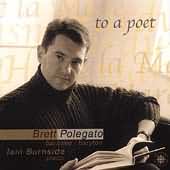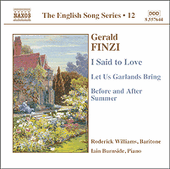Childhood among the Ferns
Poet: Thomas Hardy
Date of poem: undated
Publication date: 1928
Publisher:
Collection: Winter Words
History of Poem:
Poem
Childhood among the Ferns |
||
|---|---|---|
| 1 | I sat one sprinkling day upon the lea, | |
| 2 | Where tall-stemmed ferns spread out luxuriantly, | |
| 3 | And nothing but those tall ferns sheltered me. | |
| 4 | The rain gained strength, and damped each lopping frond, | |
| 5 | Ran down their stalks beside me and beyond, | |
| 6 | And shaped slow-creeping rivulets as I conned, | |
| 7 | With pride, my spray-roofed house. And though anon | |
| 8 | Some drops pierced its green rafters, I sat on, | |
| 9 | Making pretence I was not rained upon. | |
| 10 | The sun then burst, and brought forth a sweet breath | |
| 11 | From the limp ferns as they dried underneath: | |
| 12 | I said: 'I could live on here thus till death;' | |
| 13 | And queried in the green rays as I sate: | |
| 14 | 'Why should I have to grow to man's estate, | |
| 15 | And this afar-noised World perambulate?' | |
(Hardy, 864) |
||
Content/Meaning of the Poem:
Speaker:
Setting:
Purpose:
Idea or theme:
Style:
Form:
Synthesis:
Published comments about the poem:
✦✼✦✼✦✼✦✼✦✼✦✼✦✼✦✼✦✼✦✼✦✼✦✼✦✼✦✼✦✼✦✼✦✼✦
✦✼✦✼✦✼✦✼✦✼✦✼✦✼✦✼✦✼✦✼✦✼✦✼✦✼✦✼✦✼✦✼✦✼✦
Musical Analysis
Composition date:
Publication date:
Publisher: Boosey & Hawkes - Distributed by Hal Leonard Corporation
Tonality:
Transposition:
Duration:
Meter:
Tempo:
Form:
Rhythm:
Melody:
Texture:
Vocal Range:
Tessitura:
Dynamic Range:
Accompaniment:
Published comments about the music:
Pedagogical Considerations for Voice Students and Instructors:
✦✼✦✼✦✼✦✼✦✼✦✼✦✼✦✼✦✼✦✼✦✼✦✼✦✼✦✼✦✼✦✼✦✼✦
✦✼✦✼✦✼✦✼✦✼✦✼✦✼✦✼✦✼✦✼✦✼✦✼✦✼✦✼✦✼✦✼✦✼✦
| Pitch Analysis | ||||||
|---|---|---|---|---|---|---|
| pitch | stanza 1 |
stanza 2 |
stanza 3 |
stanza 4 |
total | |
highest |
A |
|||||
G |
||||||
F |
||||||
E |
||||||
D |
||||||
middle C |
||||||
B |
||||||
A |
||||||
G |
||||||
F |
||||||
lowest |
E |
|||||
| Rhythm Duration Analysis of Vocal Line | |||||
|---|---|---|---|---|---|
| stanza 1 | stanza 2 | stanza 3 | stanza 4 | total | |
16th note |
|||||
8th note |
|||||
dotted 8th |
|||||
quarter note |
|||||
dotted quarter |
|||||
triplet |
|||||
half note |
|||||
dotted half |
|||||
stanza total |
|||||
✦✼✦✼✦✼✦✼✦✼✦✼✦✼✦✼✦✼✦✼✦✼✦✼✦✼✦✼✦✼✦✼✦✼✦
Audio Recordings
To a Poet |
|
|
|
The Songs of Gerald Finzi to Words by Thomas Hardy
|
|
|
|
Gerald Finzi |
|
|
|
The English Song Series - 12 |
|
|
|
The following are comments by Chia-wei Lee regarding the song Childhood Among the Ferns. Dr. Lee extended permission to post this excerpt from his dissertation on February 16, 2012. His dissertation dated 2003, is entitled:
A Performance Study of Gerald Finzi's Song Cycle
"Before and After Summer"
This excerpt begins on page 58 and concludes on page 64.
The preceding were comments by Chia-wei Lee regarding the song Childhood Among the Ferns. Dr. Lee extended permission to post this excerpt from his dissertation on February 16th, 2012. His dissertation dated 2003, is entitled:
A Performance Study of Gerald Finzi's Song Cycle
"Before and After Summer"
The excerpt began on page 58 and concluded pn page 64.
The following is an analysis of Childhood among the Ferns by Gerhardus Daniël Van der Watt. Dr. Van der Watt extended permission to post this excerpt from his dissertation on October 8th, 2010. His dissertation dated November 1996, is entitled:
The Songs of Gerald Finzi (1901-1956) To Poems by Thomas Hardy
This excerpt comes from Volume II and begins on page 259 and concludes on page 268. To view the methodology used within Dr. Van der Watt's dissertation please refer to: Methodology - Van der Watt.
1. Poet
Specific background concerning poem:
The poem comes from Winter Words, published posthumously in 1928. This poem bears a strong resemblance to an event from his childhood, that Hardy remembered all his life and had recorded in Life, by the hand of his second wife, Florence Hardy:
He [Hardy] was lying on his back in the sun, thinking how useless he was, and covered his face with a straw hat. The sun's rays streamed through the interstices of the straw, the lining have disappeared. Reflecting on his experiences of the world so far as he had got, he came to the conclusion that he did not wish to grow up (Florence Hardy, 19)
Martin Seymour-Smith, in his biography, published 66 years later, continues:
The incident with the sunlight streaming through the hat remained with him for the whole of his life. It came into passages in Jude and the late poem: "Childhood among the Ferns". (Seymour-Smith, 17)
2. Poem
Childhood among the Ferns |
||
|---|---|---|
| 1 | I sat one sprinkling day upon the lea, | a |
| 2 | Where tall-stemmed ferns spread out luxuriantly, | a |
| 3 | And nothing but those tall ferns sheltered me. | a |
| 4 | The rain gained strength, and damped each lopping frond, | b |
| 5 | Ran down their stalks beside me and beyond, | b |
| 6 | And shaped slow-creeping rivulets as I conned, | b |
| 7 | With pride, my spray-roofed house. And though anon | c |
| 8 | Some drops pierced its green rafters, I sat on, | c |
| 9 | Making pretence I was not rained upon. | c |
| 10 | The sun then burst, and brought forth a sweet breath | d |
| 11 | From the limp ferns as they dried underneath: | d |
| 12 | I said: 'I could live on here thus till death;' | d |
| 13 | And queried in the green rays as I sate: | e |
| 14 | 'Why should I have to grow to man's estate, | e |
| 15 | And this afar-noised World perambulate?' | e |
(Hardy, 864) |
||
The persona, probably the poet as an old man, recalls a youthful experience of sitting among ferns taller than himself while it was reining. The fern leaves are a shelter from the light, sprinkling but when harder rain starts to come down some drops penetrate the fern cover and run down the stalks causing several streamlets to form around him. When the rain stops, the sun breaks through in full glory and the subtle play of light, shade and freshness, fills this magical place. In these circumstances, the embryonic forms of those principles that would govern Hardy's mental life, emerge from the child's mind:
"I could live on here thus till death" (l. 12)
A strong bond with nature is suggested. A sense of isolation from the world is experienced. An acceptance of the importance and finality of death is established.
"Why should I have to grow to man's estate, and this afar-noised World perambulate?" (l. 14-5)
An aversion in growing up, maturing and to change, in general, is indicated. There is a first perception of a distant, noisy world in perpetual motion that he will have to come to terms with. This statement and question, closes the poem in a mood very different from that of its opening: melancholic, pensive with even the first hints of fatalism.
The poem is in a pastoral lyrical style with a rhetorical question which introduces a sense of unease about the future and adulthood. This disperses the contentment of the childhood idyll.
The poem consists of five triplet stanzas rhyming in sets of three: aaa bbb ccc ddd eee. The metre is mostly iambic but there are small deviations from the iambic pattern.
The uncomplicated triplet structure and rhyme scheme blends well with the pastoral style and content but is belied by the unexpected utterance in the final stanza. The boy protests against fate in his reluctance to assume the responsibilities of the adult world. Perhaps this reveals something of Hardy's timidity. It is not just a wish to make the present moment last, there is a fear of leaving his safe childhood haven and going out to participate in the daunting outside world. The magical scene of innocence which is painted, is experienced with such intensity that deep philosophical musings are generated and uttered: why can a human being not retain a state of child-like innocence?
Setting
1. Timbre
VOICE TYPE/RANGE
The song is set for baritone and the range is perfect twelfth from the second B flat below middle C.
The piano accompaniment's upper extreme is the third E flat above middle C (b. 12) which occurs only once. Mostly the right hand part does not go higher than the second B flat above middle C. The lowest pitch used in the course of the song is the second C below middle C (b. 46-9) while the final three bars (b. 67-9) contain the third F below middle C. It follows that the extremes of the piano register are rarely employed and only significantly so in the final bars of the song. Here the tonic chord of b flat minor is sounded in second inversion to leave the final cadence of the song suspended in mid-air. Finzi ends the piano part with a musical 'question mark' which reiterates the rhetorical question in the preceding text. The more neutral middle sonority of the piano is favoured for the largely pastoral setting of the poem in a 3/4 or 6/8 time-signature.
There are no indications in the score for the use of pedal. The extensive indication of legato playing suggests that the pedal is to be used at the performer's discretion. Articulation plays an important role in the song. In the section (b. 3-22) which accompanies references to light rain, staccatos are used extensively in the right hand part while some half-staccatos are used in the bass mostly (b. 12-4 and 16-8). When stronger rain is referred to, legato playing dominates in the right hand while staccatos (b. 31, 32, 25-43, 46-49) are used in the bass. With the return of the sun and the more pensive mood, the legato touch dominates again (b. 54-69). Portamento accents are the strongest accents which are used and they occur fairly extensively (b. 1, 2, 6, 16-8, 23, 32, 44, 50, 54, 63 and 67) throughout the song. Their purpose remains unchanged: They highlight and mildly accentuate certain pitches or melodic fragments which are deemed important in the performance.
The atmosphere, largely carried by the piano part, carefully follows the development in the text. There are four distinct sections each with its own characteristics:
- Soft rain (b. 1-22) Pastoral, dreamy, magical, romanticized
- Stronger rain (b. 23-46) Active, mild excitement, a little consternation
- Sun appear (b. 47-55) Rich, pleasantly sunny
- Contemplation (b. 56-69) Pensive, melancholic
Different musical elements combine to achieve these subtle developments in the atmosphere but these will be discussed in further detail in the paragraphs to follow.
2. Duration
METRE
The textual metre is mostly iambic but the musical metre varies considerably. A summary is given below:
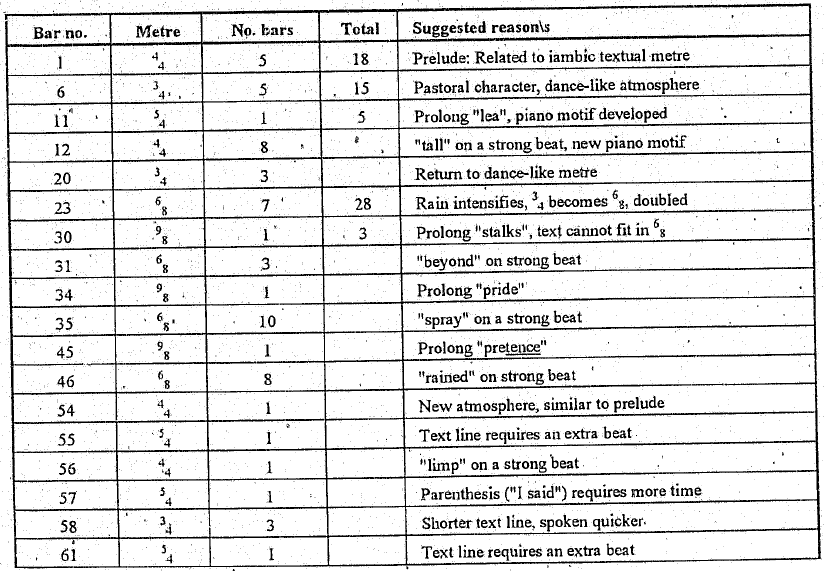

In the long middle section of the song (stronger rain b. 23-45) the 6/8 time-signature dominates. In the outer sections (soft rain b. 1-22 and sun emerging 46-67) a simple time-signature is used with a three, four- or five-beat unit, depending on what the text dictates and occasionally what the musical motif in the piano part requires.
Rhythmic motifs
Motif 1, consisting of four (and occasionally six quavers) occurs 29 times in the piano part form bars 3-22 and only once more, namely in bar 56. This motif is virtually without fail furnished with a staccato indications and suggests the falling of light rain ("sprinkling" l. 1). Motif 2 occurs 48 times, only between bars 23-37 and 38-45, in the second section of the song. This motif suggests the intensified rain and creates the effect of a double tempo moving from 3/4 to 6/8 ![]() There is also a melodic relationship with the previous material which will be discussed later. The third prominent motif consists of three quavers, mostly furnished with staccatos, and occurs 11 times in the first section (b. 12-18) and 32 times in the second section (b. 31-50) of the song. This motif occurs almost exclusively in the left-hand part and has a broken chord accompaniment function.
There is also a melodic relationship with the previous material which will be discussed later. The third prominent motif consists of three quavers, mostly furnished with staccatos, and occurs 11 times in the first section (b. 12-18) and 32 times in the second section (b. 31-50) of the song. This motif occurs almost exclusively in the left-hand part and has a broken chord accompaniment function.
Rhythmic activity vs. Rhythmic stagnation
The rhythmic activity varies according to the mood and circumstances suggested in the text. The prelude (b. 1-5) is rather static but the "soft rain" section (b. 6-22) has a quaver movement as rhythmic unit. In the "stronger rain" section (b. 23-45) the rhythmic activity doubles so that a semi-quaver movement dominates. This intensified rhythmic activity supports the suggestion of harder rain in the adjacent text. Between bars 46 and 52, the rhythmic activity returns to a quaver unit as the rain subsides and the sun slowly emerges. The general pause in bar 53 focuses the attention on the moment that the sun actually appears. The contemplative section (b. 54-69) is in parlando style with recitativo characteristics in the vocal part and a slow-moving piano part.
Rhythmically perceptive, erroneous and interesting settings
The following word and phrases have been set to music perceptively:

Lengthening of voiced consonants
The following words containing voiced consonants have been rhythmically prolonged in order to make the word more singable:

The tempo indication is Andante sostenuto ![]() Tempo deviations are numerous and follow the text development carefully:
Tempo deviations are numerous and follow the text development carefully:

3. Pitch
Intervals: Distance distribution
Interval |
Upwards |
Downwards |
Unison |
(37) |
|
Second |
22 |
33 |
Third |
9 |
8 |
Fourth |
10 |
6 |
Fifth |
5 |
9 |
Sixth |
1 |
1 |
Seventh |
0 |
1 |
Octave |
3 |
0 |
Eleventh |
0 |
1 |
There are 37 repeated pitches (or 25% of the total number), 50 rising intervals (or 34%) and 58 falling intervals (or 39%). The smaller intervals (a third and smaller) account for 109 intervals (75% of the total number) while the larger intervals (fourths and larger) account for 37 (or 25%). The abundant use of smaller intervals in the vocal part, indicates a sympathetic attitude on the part of the composer towards writing for the voice. Rising perfect fourths also play a significant role and with their strong positive connotations, have a important influence on the positive expectant atmosphere of the first 50 bars. The phrases ending in bar 37 and beginning in bar 38 are separated by a downward interval of an eleventh which serves as a change of vocal register. There are a large number of specific settings
Interval |
Bar no. |
Word/s |
Reason/s |
4th down 5th down |
10 |
on the lea |
Reinforce meaning |
8th up |
11 |
lea where |
Change of register |
4th up 5th down |
14-5 |
luxuriantly |
Emphasis |
5th up |
25 |
gained strength |
Emphasis |
5th down 4th up |
26-7 |
each lopping |
Emphasis |
4th down 8th up |
29 |
down their stalks |
Emphasis |
5th down |
32 |
slow-creeping |
Reinforce meaning |
11th down |
37-8 |
house And |
Change of register |
8th up |
38 |
though anon |
Emphasis |
6th up |
40 |
drops pierced |
Reinforce meaning, Emphasis |
4th down 5th down |
41 |
pierced its green |
Emphasis |
5th down 5th up |
42 |
I sat on |
Reinforce meaning |
8th up 6th down |
44-5 |
pretence I |
Emphasis, Change of register |
6th down |
45 |
then burst |
Emphasis, emotional content |
5th up |
54 |
limp ferns |
Reinforce emotional content |
6th down |
56 |
as I sate |
Reinforce meaning, Emphasis |
5th down 4th up |
61-2 |
afar |
Reinforce meaning |
5th up |
65 |
perambulate |
Reinforce emotional content |
5th down |
66-7 |
Melodic curve
A melodic curve of the vocal line is represented below. Certain words are indicated to show the relationship between the melodic curve and the meaning.
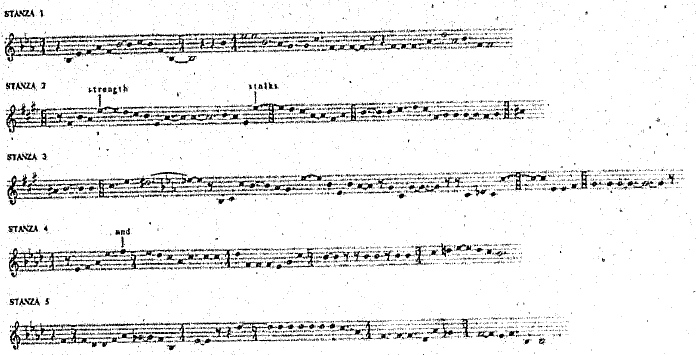
Climaxes
The two vocal climaxes are given below:
Bar no. |
Pitch |
Word |
40 |
E flat |
pierced |
54 |
F |
burst and brought forth |
The occurrence of the word "and" on the highest pitch used in the song is unfortunate. It would have been more appropriate on "burst".
Phrase lengths
Rests occasionally separate the subphrases but mostly the long phrases will have to be considered carefully for the sake of sufficient breathing. Here are some suggestions:
* |
Stanza 1 |
Subphrases conveniently separated by rests |
* |
Stanza 2 |
Breathe at 282, 312 and 341 |
* |
Stanza 3 |
Breathe at 411 and 452 |
* |
Stanza 4 |
Breathe at 555 and rests |
* |
Stanza 5 |
Breathe at 651 and rests |
The song starts in E flat major and ends in b flat minor. There are many modulations and these are summarized below.
Bar no. |
From - To |
Suggested reason/s |
14 |
E flat - D flat |
Anticipate modulation to A flat |
23 |
D flat - A |
New section, "stronger rain" |
31 |
A - f sharp |
Not text related |
34 |
f sharp - F sharp |
Stanza 2, new key |
36 |
F sharp - g sharp |
Transition to e flat min |
37 |
g sharp - e flat/E flat |
Stanza 3, new key |
43 |
E flat - f |
Not text related |
45 |
f - c |
Not text related |
50 |
c - A flat |
Anticipate stanza 4 |
59 |
A flat - D flat |
Anticipate stanza 5 |
67 |
D flat - b flat |
Melancholic end |
Chromaticism
In a context where there are many modulations, chromaticism seems more abundant than it really is. There are, however, a number of true chromatic instances. The D natural in a D flat major context occurs in bar 18 and is a chromatic lower auxiliary note in a sequential pattern from the previous bar. The next chromatic alterations which occur are in bar 36 where an enharmonic modulation occurs from F# major to e flat minor. The D# - F double sharp - A# is really E flat - G - B flat. The D natural in an A flat major context, is chromatic in the vocal part of bar 58. This setting is extremely sensitive to the text: "I could live on here thus till death". The momentary hint at the dominant key E flat major but immediate modulation to the subdominant. A flat major, provides a element of surprise at the utterance of the text. The uneasiness of a young boy considering death and wanting to resist adulthood is captured by the use of the D natural and the G flat in the very next bar. Finally, an A natural in bar 64 as part of the chord in b flat minor creates a diminished seventh chord with a minor and diminished seventh (C - E flat - G flat - A flat - A natural). This chord occurs on the word "man's" in the context: "Why should I have to grow to man's estate" portraying the child's dismay at the idea of growing up with the singular sharp dissonant chord.
HARMONY AND COUNTERPOINT
No fewer than 14 tonic second inversion chords are used in different keys. More significant, however, is the use of the surprise effect of the chord at the moment of modulation: an arrival in a new key on the I64 occurs in bars 23, 371, 451, 633, 661 and 67-9. Chord ii in various extended guises occurs several times, the most significant of these being in bars 13, 512 and 543 in each case related to the appearance or emergence of the sun.
Non-harmonic tones
Non-harmonic tones are used in abundance, the most prominent of which are suspension, appoggiatura and accented upper auxiliary notes. The function of these is consistent: they are part of the composer's expressive language through the use of mild dissonance on the beat.
Harmonic devices
Two pedal chords occur in the song, the first which portrays the emerging sun (bars 51-52) and the second in the right hand part of the last three bars. This second inversion tonic chord in b flat minor ends the song with an unstable plagal cadence (iv6 - i64). There are some melodic ostinatos used in the piano part. In the "soft rain" section (b. 6-22), the ostinato occurs in bars six to ten and again in 20 to 22, (an octave lower) and portrays the rain. The second ostinato paints the "stronger rain" (b. 23-45) and consists of a two-bar pattern which recurs three and a half times between bars 22 and 29. The second ostinato is a rhythmic variant of the first and as such is a very effective carrier of the idea of intensified rain.
Counterpoint
Counterpoint is sparsely used in the song. The rain-motif in the piano part in bars 25 and 29, is rhythmically augmented in the vocal part. The only obvious imitation occurs in bars 59 and 60 of the vocal line in bar 58. This imitation continues the idea in the text, "live on here till death", for another two bars and thus enhances the text. Lastly, the vocal line of bar 614-5 is echoed in an inverted way in the piano part of bar 622-4, this time allowing the atmosphere of the text, "in the green rays", to linger a little.
Loudness variation is given in the following summary:
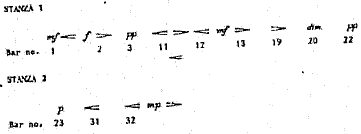
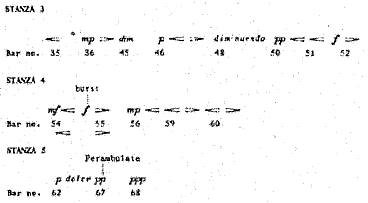
FREQUENCY
There are 4 indications in the 69 bars. There are separate indications for the voice on two occasions: in bars 11-2 and 54-5, the latter of which occurs with the vocal climax. The voice, by implication, should follow the indications given in the piano part for the rest of the bars.
RANGE
The lowest level indication, ppp occurs in the bass part of the piano in bar 68, the penultimate bar. The already unstable cadence is further enhanced by this very quiet indiction. The highest level indication, f, occurs three times (b. 1, 51 and 54). All three indictions occur with material associated with the emerging sun.
VARIETY
The indications used are:
DYNAMIC ACCENTS
The strongest accent which occurs, is the portamento. These accents have been listed and discussed in an earlier section.
The density varies loosely between three and seven parts including both piano and voice. The thickness of the piano part is represented in the following table:
No. of parts |
No. of bars |
Percentage |
2 parts |
15 |
22 |
3 parts |
28 |
40.5 |
4 parts |
15 |
22 |
5 parts |
2 |
2.5 |
6 parts |
9 |
13 |
The two-part texture occurs in the "stronger rain" section (b. 31-2 and 35-43). The rhythmic activity compensates for the thinner texture. The five- and six-part textures occur with reference to the sun or in association with the emerging sun (b. 1, 51-2, 54-5). By far the largest percentage of the song has a three or four-part texture.
the structure of the song is represented in the following table:
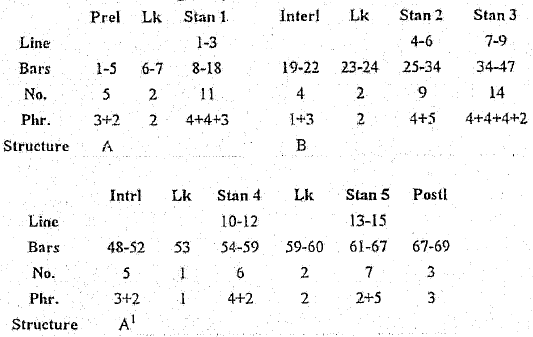
The song is in ternary form with a fairly extensive B-section and an A1-section that reaches back to the prelude, but also contains new, more melancholic material.
7. Mood and atmosphere
the mood and atmosphere portrayed in the song, follows the text carefully and falls into five distinct sections:
- Sunny introduction (b. 1-5)
This pleasantly warm, rich opening, consists of the same material in a different key from that which accompanies the appearance of the sun in a later section. The first drops of light rain are suggested. - Light rain (b. 6-22)
A facile, staccato accompaniment in simple triple metre, creates the impression of a carefree, dancing atmosphere. The descending tendency of the accompaniment suggests a drizzle descending on the fern-roofed hide-out. - Stronger rain (b. 25-50
Teeming rain is suggested by the diminished rhythmic material. The initial ostinato and continuous semi-quaver movement create a bouncing, incessant impression of a swiftly passing shower. Towards the end of the section, the activity subsides. - Emergence of the sun (b. 51-57)
Pleasant, sunny connotations appear but do not last. - Contemplation (b. 57-69)
A pensive, slightly melancholic and uneasy atmosphere closes the song and is the result of a general descending tendency, a flat directed modulatory pattern and the unstable plagal cadence in b flat minor.
General comment on style
The application of intervals in the vocal part shows a sensitive sympathy towards the voice as an instrument. The highlight of the song is the acute setting of the changing atmosphere, an all-important feature in Finzi's settings: the elements of music are coherently employed to achieve this aim. The musical formal construction is subservient to the creation of the suitable atmosphere.
Unpublished Analysis Excerpts
The following is an analysis of Childhood among the Ferns by Curtis Alan Scheib. Dr. Scheib extended permission to post this excerpt from his dissertation on February 17th, 2012. His dissertation dated 1999, is entitled:
Gerald Finzi's Songs For Baritone On Texts By Thomas Hardy: An Historical And Literary Analysis And Its Effect On Their Interpretation
This excerpt begins on page fifty-two and concludes on page fifty-four.
Childhood among the Ferns |
||
|---|---|---|
| 1 | I sat one sprinkling day upon the lea, | |
| 2 | Where tall-stemmed ferns spread out luxuriantly, | |
| 3 | And nothing but those tall ferns sheltered me. | |
| 4 | The rain gained strength, and damped each lopping frond, | |
| 5 | Ran down their stalks beside me and beyond, | |
| 6 | And shaped slow-creeping rivulets as I conned, | |
| 7 | With pride, my spray-roofed house. And though anon | |
| 8 | Some drops pierced its green rafters, I sat on, | |
| 9 | Making pretence I was not rained upon. | |
| 10 | The sun then burst, and brought forth a sweet breath | |
| 11 | From the limp ferns as they dried underneath: | |
| 12 | I said: 'I could live on here thus till death;' | |
| 13 | And queried in the green rays as I sate: | |
| 14 | 'Why should I have to grow to man's estate, | |
| 15 | And this afar-noised World perambulate?' | |
(Hardy, 864) |
||
Here Hardy speaks of childhood innocence, that innocence being protected by the canopy of ferns. There is also the typical antithesis in the last few lines, posing the question without answer and hinting of the disillusionment to come. Finzi's setting was completed some time after June of 1947 when he complained in a letter to Edmund Blunden about the difficulty of setting the word "perambulate." (Banfield, 356) Finzi apparently overcame this difficulty, as the setting of the troublesome word attests. The song begins, as seen in example 18, with a sweeping gesture in the piano that is later shown to represent the rising of the sun.

Following this joyous motive, the picturesque accompaniment continues with rain drops, in slow eighth-notes at first, then becoming sixteenths as the rain come down faster and faster. The vocal line rides this rhythmic storm in phrases designed for text declamation rather than melodic value (example 19).

The movement begins to slow however as the storm subsides and, after a measure's silence, the sun motive from the introduction returns as "The sun then burst, and brought forth a sweet breath." As the doubts of the antithetical lines are reached, the sense of movement stops and the song ends on a 6-4 chord, the dominant emphasized by a haunting motive in the bass which seems to tell of things to come.
The preceding was an analysis of Childhood among the Ferns by Curtis Alan Scheib. Dr. Scheib extended permission to post this excerpt from his dissertation on February 17th, 2012. His dissertation dated 1999, is entitled:
Gerald Finzi's Songs For Baritone On Texts By Thomas Hardy: An Historical And Literary Analysis And Its Effect On Their Interpretation
The excerpt began on page fifty-two and concluded on page fifty-four.

